Newsletter extracts
Newsletter 80 October 2020
Editor; Brian O'Riordan
Oakham Castle Horseshoes
Oakham Castle, Rutland, is the
Great Hall of the original fortified Manor House and is one of the finest
Norman buildings in England . It contains a unique collection of 230 ornate
oversize horseshoes donated by the peers of the realm. The origins of the
custom are lost in time but may date from the time of Walchelin de Ferriers, a
Norman knight, arriving in 1066, for whom the castle was built. Ferrier is
the Norman French for farrier and the horseshoe has been a symbol of the
deFerrier family since Henry de Ferrers (Wikepedia). The custom is that all
peers of the realm, on their first visit to the town, should forfeit a
horseshoe to the Lord of the Manor of Oakham. The oldest horseshoe in the
collection is one that was presented by Edward IV in 1470 after the Battle of
Losecoat Field. Recent additions to the collection are horseshoes donated by
the Princess Royal in 1999 and Prince Charles in 2003.



Oakham Casltle
Oakham Urban District Council Arms
motto: small but comparable with great
(Refers to the fact that Rutland is the smallest county in England)
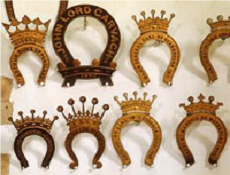
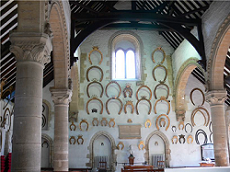
The Great Hall with horseshoes and a
closeup to show the elaborate designs.
*********************************************
Newsletter 79 January 2020
Horseshoes
By Brian O'Riordan
Charles Elliott: info@elliottsoflondon.co.uk
I came across this sculpture made entirely of old horseshoes, apart
from the antlers, while driving in the vicinity of Berkhamstead and
Tring It was made by Elliotts of London and utilizes the rusty upcycled
horseshoes to produce this magnificent red stag.
St. Dunstan (909
-988) is one of the Patron saints of Blacksmiths, The other is St.
Clement. St. Dunstan began his religious life in Glastonbury Abbey where
he was known as a musician, especially on the harp and a metalworker.
His skill in silver and goldsmithing was, of course, useful to the
monastery in making chalices and other sacred vessels etc. He was
successively Abbot of Glastonbury, Bishop of Worcester, Bishop of London
and lastly Archbishop of Canterbury. He was the most popular saint in
England for nearly two centuries until the death of St. Thomas
a’Beckett. Many stories are told about him especially those recording
his uncanny ability to detect the presence of the Devil and cleverly
defeating “Old Nick”. Many stories/legends abound about his success in
beating the Evilone.
Dunstan was working in his forge when the devil
paid him a visit, disguised as a weary traveler, needing his horse shod.
However, Dunstan grabbed the Devils cloven hoof, stuck a red hot shoe
against it and drove in the nails. The shoe was only removed when the
Devil pleaded for mercy and promised he would never again enter a house
with a horseshoe above the door. This is claimed as the origin of the
lucky horseshoe. It is customary in England to hang lucky horseshoes
with the ends pointing upwards to keep the “luck in”. A blacksmith,
replying to a blog said that over the door of the forge they nailed a
horseshoe in the traditional manner but over the fire they suspended a
horseshoe in a reverse position so that the luck poured onto the work.
Another
story relates to the Devil visiting the forge, disguised as a beautiful
woman intent on seduction. However, Dunstan espied a cloven hoof
beneath “her” elegant dress and quickly grabbed the red-hot tongs from
the furnace and grabbed the Devil’s nose at which point he revealed his
true identity and slunk painfully away.
Charles Dickens wrote in A Christmas Carol the following folk rhyme:
St. Dunstan, as the story goes,
Once pulled the Devil by the nose,
With red-hot tongs, which made him roar,
That he was heard three miles or more.
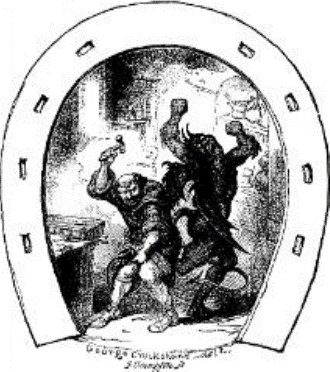
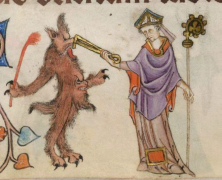
British Library, Luttrell Psalter St. Dunstan shoeing the Devil by George Cruikshank
St. Dunstan was held in such high regard as a Bishop and a
silversmith that the London Assay Office began its year of hallmark on
Dunstan’s feast day, 19th May. This was only changed when Charles II
came to the throne in 1660 who wished to have it run from his birthday,
29th May.
The blacksmith was a very important member of the community
as he could make household and farming utensils out of metal. But his
greatest value was the ability to make high class weapons and body
armour. He could also turn his hand at removing painful teeth,
painfully!
He was also the “Anvil Priest” and conducted weddings
“over the anvil”. The most famous venue was Gretna Green on the
Scottish-English border. These were called hand-fasting ceremonies and
simply required the couple to declare their intention to marry before a
witness and was legal in Scotland until 1940. English law required those
under 21 to have their parents’ consent to marry hence many eloped to
Scotland. Scottish law was amended in 1856 which required one of the
partners to have resided in Scotland for 21 days before these marriages.
This requirement was only abolished in 1977.
**********************************************************************
Newsletter 78 October 2019
The Humble Horseshoe Nail by Brian O'Riordan
“For want of a nail, the shoe was lost,
For want of a shoe, the horse was lost,
For want of a horse, the rider was lost,
For want of a rider, the battle was lost,
For want of the battle, the Kingdom was lost,
and all for the want of a horseshoe nail.”
So went the cautionary verse first recorded in 1230 by the Swabian didactic poet Freidark.
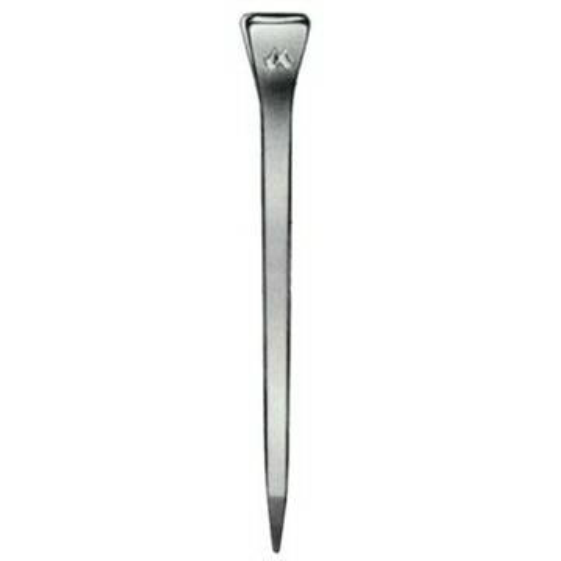
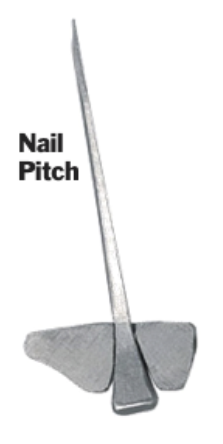
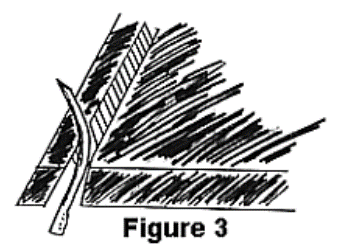
The first record of a horseshoe with nails was an archaeological find in 1897 in an Etruscan Tomb and consisted of four horseshoes with evidence of nails. However the first documentary evidence was in an inventory of horse furniture belonging to Emperor Leo of Constantinople in 900AD. The horseshoe nail is a gem of a design. It is square or rectangular in cross-section and so resists rotation. The crown is so shaped as to fit tightly into the groove of the horseshoe (Called fullers in UK and V-crease in USA) which again resists rotation and the beveled tip directs the nail towards the outside of the hoof avoiding the sensitive lamina. The tip is then nipped off and the remaining projection is clinched and turned down to lie in a prepared groove. These two latter steps anchor the nail and avoid snagging.
Stained glass artists also use the horseshoe nail to hold pieces of glass in place on the assembly table when leading. This type of nail is favoured because of the sharp tip which enters the table accurately but can also be withdrawn easily without disturbing the piece of glass. The piece of glass rests against the flat side of the shank and so less likely to cause chipping.

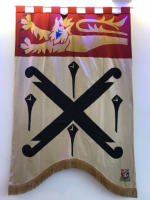 (Left) Stained glass being held in position using horseshoe nails.
(Left) Stained glass being held in position using horseshoe nails.
(Right) Banner of the Worshipful Company of Glaziers and Painters of Glass showing two grozing irons (for chipping off small pieces of glass to get a good fit) and four horseshoe nails with the bevelled tip clearly showing.
Horseshoe nail jewellery: The nail is a popular object to make jewellery as the shank is thin and malleable and the head a striking inverted trapezoid shape which can be fashioned into attractive pendants or, as with this image of a steer, into more complex shapes
A steer made of Horseshoe Nails Wolfguy in Craft Wirestorm creations
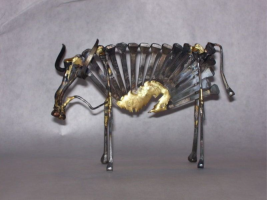
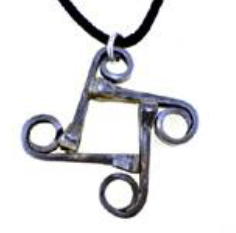
A steer made of Horseshoe Nails Wolfguy in Craft Wirestorm creations
What a versatile object is the simple horseshoe nail!
***************************************************************